∞∞∞∞∞∞∞
OMNIANA.
————
Every thing by starts, but nothing long.
Dryden.
Various; that the mind
Of desultory man, studious of change,
And pleased with novelty, may be indulged.
Cowper.
————
ANTIQUITY OF WIGS.
The Lydians, Carians, Modes, and Persians, wore wigs. This circumstance appears not only in the medals of antiquity, but in the second book of Œconomies of Aristotle, in his account of the Candaules.
————
BELLS.
Bells were first brought into use by St. Paulinus, bishop of Nola, anno 409 — famous for his piety and professional labors — in the Campania of Rome; hence a bell was called Nola or Campagna. At first they were called saints or toe-saint, or toe-sin, in process of time. But Pliny reports, that, many ages before his time, bells were in use, and called Tintin-nabula; and Suetonius says that Augustus had one put at the gate of the temple of Jupiter, to call the meeting of the people.
————
CORKSCREWS.
The notion so prevalent now-a-days about the rapid strides of the human intellect, as especially characteristic of the age, in the various branches of knowledge, particularly in the art of living, is, perhaps, too hastily received as true, inasmuch as the assertion will surely admit of arguments both pro and con, with the admission that the ancients also knew a thing or two. It is not now, however, my desire to discuss this erudite and prolific theme, but simply and graphically to entertain and instruct unlearned readers with an account of the progress of improvement in a useful appendage to their personal comfort and convenience. It nevertheless is allowed that after the most profound and diligent researches lam unable positively to affirm that the good folks of old knew much, if any thing at all, about the true method of drawing a cork, seeing that it appears exceedingly problematical whether they had either corks to draw or glass bottles to hold their liquors!
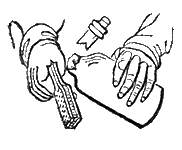
The inventor of bottles* is unknown, but these were in use for centuries before corks were thought of, and these again were employed for generations before a convenient method was found for extracting them. The exhilerating contents could then only be tasted by what is now technically called “beheading the bottle.” More expert practitioners had many opportunities of showing their skill in removing the impediment by a dextrous twist of of [[sic]] the fingers, or if that were impracticable teeth were called in as their natural auxiliaries.
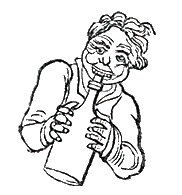
Here, however, in many cases it was doubtful whether the cork would follow the teeth, or the teeth remain with the cork, and if an obstinate remnant would remain, a nail visa ready means of dislodging the stubborn plug, particle by particle.
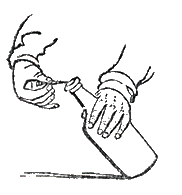
When at any time, through an impatience of the nibbling labor, or a despair of accomplishing a clean extraction at all, it was resolved at once to send the obstacle the wrong way; this was then a valuable instrument. A pair of skewers, or forks, inserted “witchwise,” [page 290:]
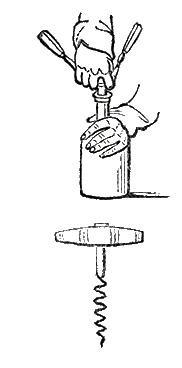
Would sometimes accomplish those difficult cases which had baffled the exertions of all the naturals. Twisting the lower extremity of the “bare bodkin” into a spiral form, and adding a handle to it, was the thought of a master genius;
And in this shape mankind for ages were contented to avail themselves of its services, and even at the present time some barbarous, uncouth countries and districts may be named where still the extractor is in most general use. In our civilized land it must yet be recollected that this was, nay is, a very inefficient machine, and the pleasure of beholding the generous beverage beaming through a crust of many years, was cruelly damped by the experience that in proportion to the pains taken in fixing the cork was the mental agony which must be endured during all attempts to remove it. Jovial fellows, who may forget those days in their moment of inspiration, may talk indeed of their Phillises, their Ianthes, their Delias, their Sacharissas, their Chloes — let them henceforth mingle a little gratitude with their admiration, and glorify a nymph greater than them all. Miss O’Rourke, like her own exquisite potteen punch, was a delightful compound of ingredients, both mental and corporeal, of the most opposite nature. The friend of Kosciusko, and the authoress of the Rhapsody, which afterward rung throughout Great Britain and in this country, to the favorite tune (Gramachree) of the patriot Polander — such another hostess was not in England wide, and no other of her order ever conferred so great a benefit on bottles suckers as she did, by her superlative invention of placing a button at the top of the screw-worm.
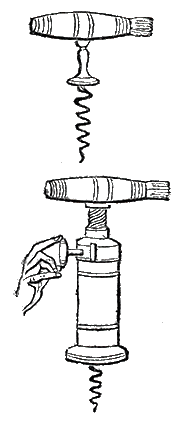
Henceforth the decanting process was a mere matter of routine. When in her green old age death laid her hand on the inventress, a piratical screw-maker also took to himself the credit and profit of the button addendum. But Miss O’Rourke shall never be forgotten, even although her masterpice [[masterpiece]], some few years later, was eclipsed, and may yet be superseded by the king's screw,
Which can receive no addition either to its beauty or convenience, except it be probably some little steam appendage to make it self-acting. These are trifling additions to a simple instrument, yet they produced a great revolution in its use and value: — equally simple improvements have still produced more wonderful effects in machines of more elaborate construction — and above all other mechanisms which can be named, on the steam engine.
An ingenious friend, whose knowledge and skill in all the appliances of matters and things, is unquestioned, after discussing the various improvements as recorded here, remarked with some surprise, that the most convenient instrument of the whole family of the screws has not been noticed. It is composed of a strong converse stem of steel, round which a flattened thread of the same metal is wound in a spiral form. The bore produced by this machine is not so apt to split the cork as the others, and he says it has other advantages too numerous to specify.
————
SQUARING THE CIRCLE.
Either there are no angles, or there are an infinity; either supposition makes the quadrature of the circle impracticable — for the proportion of figures cannot be ascertained but by angles. A round figure is the only one capable of perpetual motion. The heavenly bodies have alone perpetual motion, because the external cause of their motion is incessant in its operation.
[[Footnotes]]
[The following footnote appears at the bottom of page 289:]
* Talking of bottles, we have been informed that a gentleman of our city has made a scientific nomenclature, and arranged bottles into genera, species, etc., he designates his new science by the apt cognomen Ascology, from the Greek word Aocos (ascos) a bottle.
∞∞∞∞∞∞∞
Notes:
The authorship of this series is not certain, but has often been attributed to Poe, as it is by Heartman and Canny (1943).
∞∞∞∞∞∞∞
[S:0 - BGM, 1840] - Edgar Allan Poe Society of Baltimore - Works - Misc - Omniana [part 03]